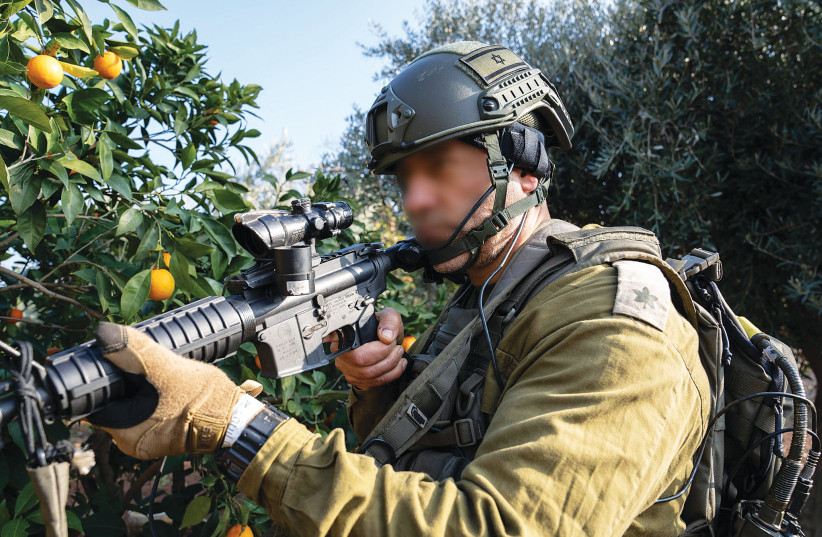After visiting the Lebanese border and seeing Units 769 and the Devorah Unit up close during a training drill, and interviewing several commanders in the field, here are seven points about security issues that The Jerusalem Post learned from the visit.
1. The Lebanese/Hezbollah front today is viewed by IDF commanders in the field not as a separate front, but as part of the multi-front Iranian proxy war. Sources view what happens in Iran, Gaza and even the West Bank as influencing tensions and potential escalation on this border. Their analysis is that the ethos of Hezbollah is to identify with the Palestinian struggle against Israel, including by using its political arm to build support among the broader Lebanese public.
It was pointed out that Hezbollah has a statue on the Lebanese/Israeli border that is nearly identical to a statue in Khan Yunis in Gaza about a global campaign to return to Palestine – a euphemism for wiping out Israel. Commanders seem to view Hezbollah as temporarily deterred, but with sudden escalation a possibility at any point based on developments on other fronts.
2. The Lebanese/Hezbollah killing of a UNIFIL soldier is viewed as clearly not accidental. Rather, Hezbollah is viewed as categorizing UNIFIL as getting in the way. Sources believe the Lebanese terrorist group is razor-focused on exercising its primacy, sovereignty and control of all parts of Lebanon and will act aggressively, even using deadly force against UNIFIL to make its point following an August 2022 decision by the UN to expand aspects of UNIFIL’s operations.
3. No more attack tunnels: Surprisingly, the IDF says Hezbollah has not tried and does not plan to try to rebuild its cross-border attack tunnels after the IDF cleared and destroyed most of them in 2018, and the rest not long after. Hamas has tried multiple times to reconstitute its tunnel-attack strategy since the IDF started in 2014 battling the Gaza attack tunnel issue more aggressively.

Yet Hezbollah has thrown in the towel for the foreseeable future on that issue, calculating that it lost too much time, money and energy in the failed endeavor, as well as leaning on its approximately 150,000-rocket arsenal to threaten Israel.
What happens if Hezbollah hits an Israeli chemical site?
4. The home-front threat and defense that most Israelis think about, if they consider the issue at all, is bomb shelters for individual family residents. The Post got to see the IDF and fire officials cooperate on the ground as they had to wade through the fog of a realistic and dangerous scenario in which a chemical facility in the North had been hit by Hezbollah rockets.
A high-ranking fire official appearing to be in his 50s conferred with senior IDF officials who were likely a decade or two younger than him about handling the issue. He told the IDF officials that all Metulla villagers had been told to shut off their air conditioning units and to keep their windows shut to avoid airborne chemical exposure. There were discussions about the exact safety radius regarding from how many hundreds of meters (the exact number cannot be disclosed for security reasons) soldiers could approach the destroyed (in the imaginary exercise) facility to guard it.
There were also different parameters for the firemen themselves in terms of when they could enter the facility in special chemical-proof suits, versus the initial stage, when possibly even they could not get too close.
Hezbollah gets close
5. Although these events do not always make the news, sources indicated that there are a sizable number of low-grade friction incidents on the border where Hezbollah personnel get too close to the fence, leading IDF soldiers to fire in the air. There are also criminal smugglers being arrested and incidents of random persons seeking work breaking through the fence and being sent back to Lebanon the same day.
Hezbollah's "environmentalists"
6. As early as 2017, IDF intelligence reported that the NGO Green Without Borders, a Lebanese environmental organization dealing mostly with forestation, operated a number of forward facilities near the Israeli-Lebanese border which Hezbollah used for its own activities.
In June 2017 and October 2018, the IDF Spokesperson’s Office reported that the organization’s facilities and activities near the Israeli border serve as a front for Hezbollah military operatives disguised as civilians, violating UN Security Council Resolution 1701. There have been other such events since, and the Post was able to witness certain outpost areas near Metulla nominally belonging to the NGO, but which IDF sources said are being used to collect intelligence about IDF movements.
Reducing the issue of theft of IDF ammunition and gear
7. Sources praised new technologies they have been given for better security in terms of more security cameras, sensors and general security investment of IDF bases in the North that have a history of their weapons being stolen. The IDF view appeared to be that they could do the job of securing the bases with these additional resources, but at the same time, they would appreciate even more if possible and recognize that the problem has not been eliminated.
